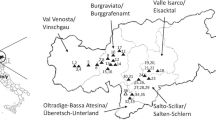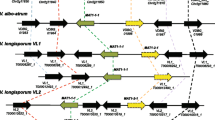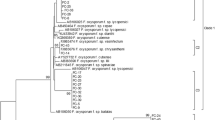Abstract
Verticillium longisporum is an allodiploid hybrid fungus that consists of at least three groups, A1/D1, A1/D2, and A1/D3. PCR-based analysis of 18S rDNA, 5.8S rDNA-ITS region, mtSSU-rDNA, cytochrome b gene, and mating type gene, as well as RAPD analysis, revealed that Verticillium wilt of cabbage in Gunma Prefecture in Japan is caused by two groups of V. longisporum—A1/D1 and A1/D3—and by V. dahliae. A1/D1 and A1/D3 lineage strains were equally distributed in cabbage fields, whereas V. dahliae strains were most frequently isolated. The proportion of the three types of Verticillium had not changed in 1998 and 2008. Although both V. longisporum strains produced longer conidia than the V. dahliae strains, the A1/D3-type strains produced larger conidia than A1/D1-type strains. In addition, the A1/D3-type strains formed microsclerotia that were distinguishable from those of A1/D1-type of V. longisporum and V. dahliae. The pathogenicity of the A1/D3-type strains on cabbage was similar to that of the A1/D1-type strains. These results will contribute to understanding of genotypic diversity, distribution, and pathogenicity of Verticillium species pathogenic on cabbage.




Similar content being viewed by others
References
Babadoost M, Chen W, Bratsch AD, Eastman CE (2004) Verticillium longisporum and Fusarium solani: two new species in the complex of internal discoloration of horseradish roots. Plant Pathol 53:669–676
Banno S, Saito H, Sakai H, Urushibara T, Ikeda K, Kabe T, Kemmochi I, Fujimura M (2011) Quantitative nested real-time PCR detection of Verticillium longisporum and V. dahliae in the soil of cabbage fields. J Gen Plant Pathol 77:282–291
Barbara DJ, Clewes E (2003) Plant pathogenic Verticillium species: how many of them are there? Mol Plant Pathol 4:297–305
Fahleson J, Hu Q, Dixelius C (2004) Phylogenetic analysis of Verticillium species based on nuclear and mitochondrial sequences. Arch Microbiol 181:435–442
Ikeda K, Banno S, Watanabe K, Fujinaga M, Ogiso H, Sakai H, Tanaka H, Miki S, Shibata S, Shiraishi T, Fujimura M (2012) Association of Verticillium dahliae and Verticillium longisporum with Chinese cabbage yellows and their distribution in the main production areas of Japan. J Gen Plant Pathol 78:331–337
Inderbitzin P, Davis RM, Bostock RM, Subbarao KV (2011) The ascomycete Verticillium longisporum is a hybrid and a plant pathogen with an expanded host range. PLoS ONE 6:e18260
Karapapa VK, Typas MA (2001) Molecular characterization of the host-adapted pathogen Verticillium longisporum on the basis of a group-I intron found in the nuclear SSU-rRNA gene. Curr Microbiol 42:217–224
Karapapa VK, Bainbridge BW, Heale JB (1997) Morphological and molecular characterization of Verticillium longisporum comb. nov., pathogenic to oilseed rape. Mycol Res 101:1281–1294
Kemmochi I, Sakai H (2004) Verticillium wilt of plant species in cabbage field infested with Verticillium longisporum and V. dahliae (in Japanese with English summary). Jpn J Phytopathol 70:99–105
Kemmochi I, Sakai H, Shiraishi T (1999) Pathogenicity of Verticillium longisporum and Verticillium dahliae isolated from cabbage (Brassica oleracea L. var. capitata) to some crops (in Japanese). Ann Rep Kanto Tosan Plant Prot Soc 46:31–34
Kemmochi I, Hinoto M, Sakai H (2003) Pathogenicity of Verticillium dahliae and V. longisporum on broccoli and cauliflower and control of Verticillium wilt of cabbage with broccoli residues (in Japanese with English summary). Jpn J Phytopathol 69:189–197
Klosterman SJ, Atallah ZK, Vallad GE, Subbarao KV (2009) Diversity, pathogenicity, and management of Verticillium species. Ann Rev Phytopathol 47:39–62
Li KN, Rouse DI, German TL (1994) PCR primers that allow intergeneric differentiation of ascomycetes and their application to Verticillium spp. Appl Environ Microbiol 60:4324–4331
Sakai H, Shiraishi T, Suwa S, Kemmochi I, Ohtsuka K, Urushibara T (1998) The occurrence of Verticillium wilt of cabbage in Gunma prefecture and the pathogenic group of its pathogens (abstract in Japanese). Jpn J Phytopathol 64:331
Sakai H, Shiraishi T, Urushibara T (2001) Occurrence of Verticillium wilt of cabbage by Verticillium longisporum and V. dahliae (abstract in Japanese). Jpn J Phytopathol 67:160–161
Tran VT, Braus-Stromeyer SA, Timpner C, Braus GH (2013) Molecular diagnosis to discriminate pathogen and apathogen species of the hybrid Verticillium longisporum on the oilseed crop Brassica napus. Appl Microbiol Biotechnol 97:4467–4483
Usami T, Itoh M, Amemiya Y (2009) Asexual fungus Verticillium dahliae is potentially heterothallic. J Gen Plant Pathol 75:422–427
Acknowledgments
This work was supported in part by a grant of Strategic Research Foundation Grant-aided Project for Private Universities from the Ministry of Education, Culture, Sports, Science, and Technology of Japan.
Author information
Authors and Affiliations
Corresponding author
Electronic supplementary material
Below is the link to the electronic supplementary material.
10327_2014_568_MOESM1_ESM.pptx
Supplementary material 1 (PPTX 348 kb). Fig. S1. Polymerase chain reaction (PCR) assay to detect 18S rDNA and 5.8S rDNA in Verticillium strains obtained from cabbage. (a) Gene structure of nuclear rDNA gene of V. dahliae and V. longisporum. (b) PCR amplification of 18S rDNA gene region. M: 1-kb DNA ladder marker (Fermentas Life Sciences, Burlington, ON, Canada) (c) PCR amplification of 5.8S rDNA-ITS region. M: 100-bp ladder marker (New England Biolabs, Ipswich, MA, USA) Genomic DNA isolated from the eight V. longisporum strains (CA1, CA4, CA9, CA10, CA12, CA34, CA54, and CA58), two V. dahliae strains (CA39 and CA43), V. longisporum strain (84013), and V. albo-atrum strain (Vaa-HP) was used as template DNA. Fig. S2. Polymerase chain reaction-restriction fragment length polymorphism (PCR-RFLP) assays for mitochondrial small-subunit rDNA (mtSSU-rDNA) and cytochrome b genotyping. PCR-RFLP assay of (a) mtSSU-rDNA and (b) cytochrome b. The mtSSU-rDNA and cytochrome b gene region were amplified using primer sets NMS1 plus NMS2 and cobF1 plus cobR1, respectively. PCR products were digested with restriction enzymes (a) MseI and (b) DdeI, respectively. Genomic DNA was purified from the eight Verticillium longisporum strains (CA1, CA4, CA9, CA10, CA12, CA34, CA54, and CA58), two V. dahliae strains (CA39 and CA43), V. longisporum strain (84013), and V. albo-atrum strain (Vaa-HP) and used as template DNAs. M: 100-bp ladder marker (New England Biolabs, Ipswich, MA, USA). Fig. S3. Polymerase chain reaction (PCR) assays to detect the mating type gene in Verticillium strains obtained from cabbage. PCR amplification of (a) MAT1-1-1 and (b) MAT1-2-1. PCR products were analyzed using a MultiNA microchip electrophoresis system (Shimadzu, Kyoto, Japan). Genomic DNA isolated from the eight V. longisporum strains (CA1, CA4, CA9, CA10, CA12, CA34, CA54, and CA58), three V. dahliae strains (CA26, CA39, and CA43), V. longisporum strain (84013), V. dahliae strain (84023), and V. albo-atrum strain (Vaa-HP) was used as template DNA
Rights and permissions
About this article
Cite this article
Banno, S., Ikeda, K., Saito, H. et al. Characterization and distribution of two subtypes of Verticillium longisporum isolated from cabbage fields in Japan. J Gen Plant Pathol 81, 118–126 (2015). https://doi.org/10.1007/s10327-014-0568-5
Received:
Accepted:
Published:
Issue Date:
DOI: https://doi.org/10.1007/s10327-014-0568-5




